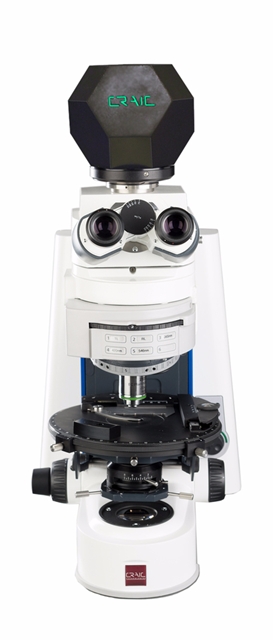Perovskite materials are highly valued for their efficient, tunable light emission, a property that opens up new possibilities in displays, sensors, lasers, and other photonic technologies. But producing light is only one aspect of what modern photonic devices require. Equally as important is the ability to control how that light behaves, including its wavelength, direction, and coherence, which directly impacts device performance and functionality. Optical quasi-bound-states-in-the-continuum (quasi-BICs) provide a precise mechanism for controlling perovskite emissions using carefully engineered photonic structures. By aligning these structures with the emission characteristics of perovskites, researchers can enhance spectral control, improve efficiency, and enable new device functionalities.
Across crime scenes and forensic laboratories, some of the most decisive evidence arrives in the form of almost invisible threads. Microfibers, released from everyday textiles like clothing or furnishings, can transfer during fleeting contact and linger undetected. Their ability to connect people, places, and objects has made them a cornerstone of forensic trace analysis. But when two fibers appear virtually identical under a microscope, how do investigators tell them apart? The answer lies in a technique that examines the molecular traces left behind by light itself: UV-Vis-NIR microspectroscopy.
Controlling light’s polarization at the moment it is emitted is a powerful capability. It unlocks new possibilities in optical displays, quantum information science, and biosensing. At the heart of this capability is chirally selective luminescence, where light strongly prefers one circular polarization over the other. Traditional methods rely on chiral molecules, but their inherent asymmetry is often too weak to be practical. Instead, researchers are turning to a more robust solution. By combining achiral emitters with twisted metasurfaces, they can generate robust, tunable circularly polarized light in ultra-thin devices. That degree of control is only possible through meticulous spatial engineering, guided by thin film thickness measurements and validated through UV-Vis-NIR microspectroscopy. Together, these tools are redefining how circular polarization is designed, quantified, and applied.
Circularly polarized luminescence (CPL) is vital for emerging technologies in optics and display design, but generating it with both efficiency and full-spectrum color remains a challenge. Quantum dots provide tunable brightness across the visible range but emit unpolarized light. Chiral cellulose nanocrystals (CNCs), by contrast, offer a structured, bio-derived platform for controlling light polarization. When combined, they form a system capable of transforming color-rich emission into precisely polarized output.
CRAIC Technologies Introduces Revolutionary Maceral Identification Solution for Coal Analysis
[San Dimas, CA, June 30, 2025] — CRAIC Technologies, a leading innovator in the field of scientific instrumentation, is proud to announce the launch of its groundbreaking maceral identification solution, designed to revolutionize coal analysis for researchers and industries worldwide.
Coal, a cornerstone of global energy production, undergoes intricate analysis processes to determine its composition and suitability for various applications. Macerals, the organic constituents of coal, play a crucial role in understanding its quality, properties, and behavior during combustion. Accurate maceral identification is essential for optimizing coal usage, improving efficiency, and mitigating environmental impact. Traditionally, maceral identification has been a time-consuming and labor-intensive process, requiring extensive sample preparation and manual microscopic analysis. However, CRAIC Technologies' innovative solution leverages high speed imaging techniques to streamline and speed completion of this critical task.
"Our new maceral identification solution represents a significant advancement in coal analysis technology," said Dr. Paul Martin, CEO of CRAIC Technologies. "By combining advanced imaging capabilities, servo driven scanning and sophisticated software, we are empowering petrographers and industry professionals to achieve unprecedented levels of accuracy, efficiency, and insight in maceral identification."
 CRAIC Technologies' maceral identification solution promises to enhance throughput of coal analysis across a range of applications, including mining, energy generation, environmental research, and academic study. By empowering researchers and industry professionals with advanced tools and capabilities, the company aims to drive innovation, efficiency, and sustainability in the global coal industry.
CRAIC Technologies' maceral identification solution promises to enhance throughput of coal analysis across a range of applications, including mining, energy generation, environmental research, and academic study. By empowering researchers and industry professionals with advanced tools and capabilities, the company aims to drive innovation, efficiency, and sustainability in the global coal industry.
For more information about CRAIC Technologies' maceral identification solution and other innovative scientific instrumentation offerings, please visit
microspectra.com or contact us at sales@microspectra.com.
About CRAIC Technologies:
CRAIC Technologies is a leading provider of innovative spectroscopic solutions, specializing in the design and manufacture of advanced instruments for spectral analysis and imaging. With a commitment to excellence and customer satisfaction, CRAIC Technologies continues to push the boundaries of spectroscopic technology, empowering researchers and industry professionals with state-of-the-art tools for scientific discovery and analysis.
Contact information:
CRAIC Technologies, Inc.
https://www.microspectra.com/
sales@microspectra.com
+1-310-573-8180
- Why microspectrophotometers matter in photovoltaics, 2d materials, and semiconductors
- Decoding cholesteric-superhelix films: circularly polarized luminescence from upconversion nanorods
- Tools for Microscale metasurface characterization: what researchers need to know
- How to characterize antireflection coatings on curved surfaces with microspectroscopy

